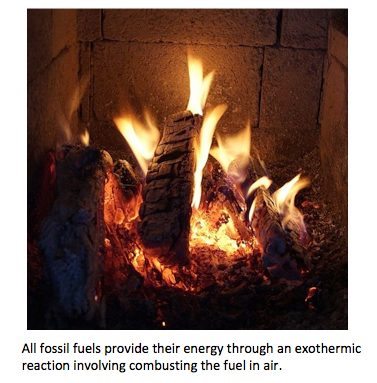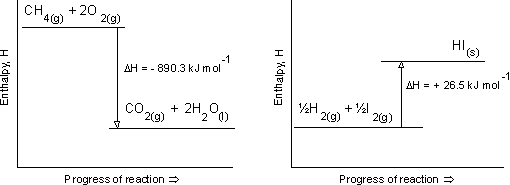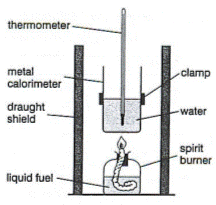5.1 Measuring energy changes
Written specifically for students to provide help and support for the IB Diploma chemistry programme this page provides full coverage of the syllabus content of Topic 5.1 Measuring energy changes. It encourages you to think critically and provides many questions with full worked answers so that you can monitor and improve your knowledge and understanding.


 Learning outcomes
Learning outcomes
 After studying this topic you should be able to:
After studying this topic you should be able to:
Understand:
- Heat is a form of energy.
- Temperature is a measure of the average kinetic energy of the particles.
- Energy is conserved in chemical reactions.
- Endothermic or exothermic chemical reactions involve the transfer of heat between the system and the surroundings.
- The enthalpy change, ΔH, for chemical reactions is measured in kJ mol-1.
- ΔH⦵ is used to express enthalpy changes under standard conditions including standard states.
Apply your knowledge to:
- Calculate the heat change when the temperature of a pure substance is changed using q = mcΔT.
- Perform a calorimetry experiment for an enthalpy of reaction and evaluate the results.
Relationships & vocabulary
Nature of science
The conservation of energy is an example of one of the fundamental principles of science.
Measuring energy transfers between systems and surroundings requires making careful observations.
International-mindedness
The SI unit of temperature is the Kelvin (K). The USA uses the Fahrenheit scale (°F) for all non-scientific communication but almost all other countries use the Celsius scale (°C), which has the same incremental scaling as the Kelvin scale.
For more examples and links to International mindedness, Theory of knowledge, utilization etc. see separate page which covers all of Topics 5 & 15: Energetics/thermochemistry.
Vocabulary
| endothermic | exothermic | enthalpy | standard enthalpy change of reaction, ΔH |
| enthalpy diagram | calorimeter | specific heat capacity |
Learning slides
You can use this slide gallery for learning or for reviewing concepts and information. It covers all the key points in the syllabus for this sub-topic.
Something to think about
1. Problems with enthalpy diagrams
It is not difficult to find enthalpy level diagrams in books or on the Internet and most teachers will draw out simple ones themselves. The typical diagram below which actually gives the values for two specific reactions, one exothermic and one endothermic is from the website avogadro.co.uk.

What is perhaps not appreciated is the labelling of the y-axis. It is an enthalpy diagram so it should be labelled enthalpy as above - the problem is that no scale can ever be given as the enthalpy values for both the reactants and the products can never be known. This important fact is not obvious from these diagrams and there is a danger that they can give you a misleading message if it is not made clear. All that can ever be measured is the difference between the two values, i.e. the enthalpy change, ΔH. The x-axis also causes some problems. 'Progress of reaction' is often used when the activation energy or some intermediate is also shown on the diagram. All that a simple enthalpy level diagram shows is the initial and final states and they could quite legitimately be placed one above the other so that no x-axis is required (as we do for energy diagrams of energy levels within an atom).
2. What is the 'true' value?
 One of the best practicals you can do is to determine the enthalpy of combustion of a flammable liquid using a spirit burner underneath a beaker containing a known mass of water (see right). The experiment is fraught with problems such as incomplete combustion, heat loss and mass loss through evaporation when finding the mass of the burner before and after the combustion. However the calculations involved in determining the result cover this sub-topic well and the experiment also lends itself to a thorough and meaningful evaluation and a discussion as to how the experimental method could be improved. To do this thoroughly the literature ('accepted') value needs to be known so that the percentage error can be determined. The problem is "What is the literature value?"
One of the best practicals you can do is to determine the enthalpy of combustion of a flammable liquid using a spirit burner underneath a beaker containing a known mass of water (see right). The experiment is fraught with problems such as incomplete combustion, heat loss and mass loss through evaporation when finding the mass of the burner before and after the combustion. However the calculations involved in determining the result cover this sub-topic well and the experiment also lends itself to a thorough and meaningful evaluation and a discussion as to how the experimental method could be improved. To do this thoroughly the literature ('accepted') value needs to be known so that the percentage error can be determined. The problem is "What is the literature value?"
The IB seems to place great emphasis on you stating your experimental value together with the total uncertainties. Yet the various data books available never state an uncertainty in their values. One liquid that could be used in the spirit burner is methylbenzene (toluene). The following values can be found in the standard data books for the enthalpy of combustion of methylbenzene.

Literature values for the enthalpy of combustion, ΔHc⦵, of methylbenzene (left)1
1. – 3908 kJ mol-1
2. – 3909 kJ mol-1
3. – 3907 kJ mol-1
4. – 3910 kJ mol-1
This emphasises several points. Firstly, that you should give the source of your 'literature value' as different sources give different values and secondly why is the IB so 'hung up' on students at this age calculating all their uncertainties when in the scientific world the recognized data books do not include them? It also strongly elicits the TOK question "Which one is the true value?"
It might also be worth pointing out that some Internet sources give other different values. For example, 5. – 3906 kJ mol-1 and 6. – 3916 kJ mol-1.
1Sources:
1. Handbook of Chemistry and Physics, 72nd Ed. 1992
2. Chemistry Data Book ,Stark and Wallace, 2nd Ed. 1982 and IB Chemistry Data Booklet (pre-2009 version)
3. Binas, 1992
4. IB Chemistry Data Booklet (post 2009 version)
5. J.Chem.Eng.Data, 1969 14 (1), p 102-106 (Note this actually gives the value as -934.49 ± 0.12 kilocalories mol-1 which is equivalent to -3906 ± 0.5 kJ mol-1 so it does include uncertainties.)
6. Wikipedia (Note this gives the value as – 40.589 MJ kg-1 equivalent to 3740 kJ mol-1. However this is the Low Heating Value which means the enthalpy of vaporization of water has been subtracted. Adding this value for 4 mols of water gives an extra – 176 kJ of energy which brings the total to – 3916 kJ mol-1.
Test your understanding of this topic
(Note that your teacher may have restricted your access to some or all of these questions and worked answers if they are going to use them as a class test or set them as an assignment.)
For ten 'quiz' multiple choice questions with the answers explained see MC test: Measuring energy changes.
For short-answer questions see Measuring energy changes questions.
More resources
1. A nice demonstration by Professor Bob Burk of Carleton University, Ottowa of an endothermic reaction between two solids, barium hydroxide and ammonium nitrate. It also illustrates the importance of entropy change too.
2. One for you to try at home - or maybe not? An exothermic reaction in the palm of your hand.
3. Most students realise that their own calorimetry experiments give poor results due mainly to heat loss and incomplete combustion. This video shows how a bomb calorimeter works to overcome these problems and determine accurate enthalpies of combustion. (Remember though that a bomb calorimeter is not on the syllabus.)

 IB Docs (2) Team
IB Docs (2) Team 


















